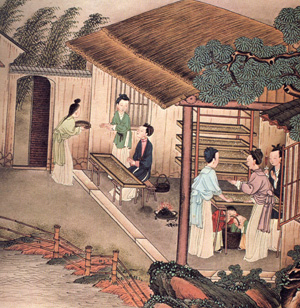- By admin
- In SilkRoadKnowledge
- 2017-12-11
History of Silk
*After eight or nine days in a warm, dry place the cocoons are ready to be unwound. First they are steamed or baked to kill the worms, or pupas. The cocoons are then dipped into hot water to loosen the tightly woven filaments. These filaments are unwound onto a spool. Each cocoon is made up of a filament between 600 and 900 meters long! Between five and eight of these super-fine filaments are twisted together to make one thread.
*Finally the silk threads are woven into cloth or used for embroidery work. Clothes made from silk are not only beautiful and lightweight, they are also warm in cool weather and cool in hot weather.
Literary sources such as The Book of History, and The Book of Rites give further information about sericulture. Reeling silk and spinning were always considered household duties for women, while weaving and embroidery were carried out in workshops as well as the home. In every silk-producing province the daughters, mothers and grandmothers of every family devoted a large part of the day for six months in a year to the feeding, tending and supervision of silkworms and to the unraveling, spinning, weaving, dyeing and embroidering of silk. By the fifth century BC, at least six Chinese provinces were producing silk. Each spring, the empress herself inaugurated the silk-raising season, for silk production was the work of women all over China. The technique and process of sericulture were guarded secrets and closely controlled by Chinese authorities. Anyone who revealed the secrets or smuggled the silkworm eggs or cocoons outside of China would be punished by death.

SILK DEVELOPMENT IN CHINA
When silk was first discovered, it was reserved exclusively for the use of the ruler. It was permitted only to the emperor, his close relations and the very highest of his dignitaries. Within the palace, the emperor is believed to have worn a robe of white silk; outside, he, his principal wife, and the heir to the throne wore yellow, the color of the earth.
Gradually the various classes of society began wearing tunics of silk, and silk came into more general use. As well as being used for clothing and decoration, silk was quite quickly put to industrial use by the Chinese. This was something which happened in the West only in modern times. Silk, indeed, rapidly became one of the principal elements of the Chinese economy. Silk was used for musical instruments, fishing-lines, bowstrings, bonds of all kinds, and even rag paper, the word's first luxury paper. Eventually even the common people were able to wear garments of silk.
During the Han Dynasty, silk ceased to be a mere industrial material and became an absolute value in itself. Farmers paid their taxes in grain and silk. Silk began to be used for paying civil servants and rewarding subjects for outstanding services. Values were calculated in lengths of silk as they had been calculated in pounds of gold. Before long it was to become a currency used in trade with foreign countries. This use of silk continued during the Tang as well. It is possible that this added importance was the result of a major increase in production. It found its way so thoroughly into the Chinese language that 230 of the 5,000 most common characters of the mandarin "alphabet" have silk as their "key".
A SECRET OUT TO THE WORLD
In spite of their secrecy, however, the Chinese were destined to lose their monopoly on silk production. Sericulture reached Korea around 200 BC, when waves of Chinese immigrants arrived there. Silk reached the West through a number of different channels. Shortly after AD 300, sericulture traveled westward and the cultivation of the silkworm was established in India.
It is also said that in AD 440, a prince of Khotan ( today's Hetian)--a kingdom on the rim of Taklamakan desert -- courted and won a Chinese princess. The princess smuggled out silkworm eggs by hiding them in her voluminous hairpiece. This was scant solace to the silk-hungry people of the West, for Khotan kept the secret too. Why share it with the westerners and kill a good market?
Then around AD 550, two Nestorian monks appeared at the Byzantine Emperor Justinian's court with silkworm eggs hid in their hollow bamboo staves. Under their supervision the eggs hatched into worms, and the worms spun cocoons. Byzantium was in the silk business at last. The Byzantine church and state created imperial workshops, monopolizing production and keeping the secret to themselves. This allowed a silk industry to be established in the Middle East, undercutting the market for ordinary-grade Chinese silk. However high-quality silk textiles, woven in China especially for the Middle Eastern market, continued to bring high prices in the West, and trade along the Silk Road therefore continued as before. By the sixth century the Persians, too, had mastered the art of silk weaving, developing their own rich patterns and techniques. It was only in the 13th century the time of the Second Crusades that Italy began silk production with the introduction of 2000 skilled silk weavers from Constantinople. Eventually silk production became widespread in Europe.
Related destinations
Why Choose Us?
We are the top Silk Road tour operator based in Dunhuang, China. We focus on providing well designed Silk Road China Tours with resonable price and thoughtful service.
- Easy & carefree booking
- The best value
- Great travel experience
- Locally operated
Hot Tours
-

6 days Gansu tour to Binglingsi, Xiahe and Langmusi
Tour type : Private tour Price : from *** Destinations : Lanzhou - linxia - Xiahe - Langmusi - Hezuo - Lanzhou -

12 Days Gansu Highlights Tour
Tour type : Private tour Price : from *** Destinations : Xian – Tianshui – Lanzhou – Xiahe – Langmusi – Hezuo – Zhangye – Jiayuguan - Dunhuang -

10 Days Silk Road Classic Tour
Tour type : Private tour Price : from *** Destinations : Xian - Zhangye - Jiayuguan - Dunhuang - Turpan - Urumqi -

5 Days Zhangye - Alxa youqi Highlights Tour
Tour type : Private Tour Price : from *** Destinations : Zhangye - Alax youqi - Zhangye

